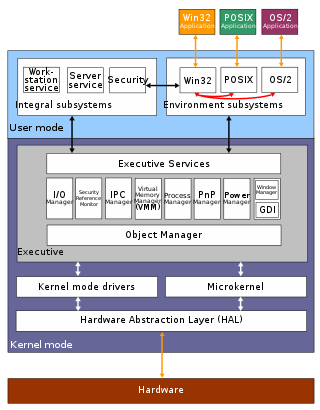Related Research Articles
The Internet protocol suite, commonly known as TCP/IP, is a framework for organizing the set of communication protocols used in the Internet and similar computer networks according to functional criteria. The foundational protocols in the suite are the Transmission Control Protocol (TCP), the User Datagram Protocol (UDP), and the Internet Protocol (IP). Early versions of this networking model were known as the Department of Defense (DoD) model because the research and development were funded by the United States Department of Defense through DARPA.
The Address Resolution Protocol (ARP) is a communication protocol used for discovering the link layer address, such as a MAC address, associated with a given internet layer address, typically an IPv4 address. This mapping is a critical function in the Internet protocol suite. ARP was defined in 1982 by RFC 826, which is Internet Standard STD 37.

The Graphics Device Interface (GDI) is a legacy component of Microsoft Windows responsible for representing graphical objects and transmitting them to output devices such as monitors and printers. It was superseded by Direct2D API. Windows apps use Windows API to interact with GDI, for such tasks as drawing lines and curves, rendering fonts, and handling palettes. The Windows USER subsystem uses GDI to render such UI elements as window frames and menus. Other systems have components that are similar to GDI; for example: macOS has Quartz, and Linux and Unix have X Window System and Wayland.
A virtual private network (VPN) is a mechanism for creating a secure connection between a computing device and a computer network, or between two networks, using an insecure communication medium such as the public Internet.

In IEEE 802 LAN/MAN standards, the medium access control sublayer is the layer that controls the hardware responsible for interaction with the wired, optical or wireless transmission medium. The MAC sublayer and the logical link control (LLC) sublayer together make up the data link layer. The LLC provides flow control and multiplexing for the logical link, while the MAC provides flow control and multiplexing for the transmission medium.
Zero-configuration networking (zeroconf) is a set of technologies that automatically creates a usable computer network based on the Internet Protocol Suite (TCP/IP) when computers or network peripherals are interconnected. It does not require manual operator intervention or special configuration servers. Without zeroconf, a network administrator must set up network services, such as Dynamic Host Configuration Protocol (DHCP) and Domain Name System (DNS), or configure each computer's network settings manually.
IEEE 802.1X is an IEEE Standard for port-based network access control (PNAC). It is part of the IEEE 802.1 group of networking protocols. It provides an authentication mechanism to devices wishing to attach to a LAN or WLAN.

In computing, the Preboot eXecution Environment, PXE specification describes a standardized client–server environment that boots a software assembly, retrieved from a network, on PXE-enabled clients. On the client side it requires only a PXE-capable network interface controller (NIC), and uses a small set of industry-standard network protocols such as DHCP and TFTP.
Peer Name Resolution Protocol (PNRP) is a peer-to-peer protocol designed by Microsoft. PNRP enables dynamic name publication and resolution, and requires IPv6.
As the next version of Windows NT after Windows 2000, as well as the successor to Windows Me, Windows XP introduced many new features but it also removed some others.
Compound TCP (CTCP) is a Microsoft algorithm that was introduced as part of the Windows Vista and Window Server 2008 TCP stack. It is designed to aggressively adjust the sender's congestion window to optimise TCP for connections with large bandwidth-delay products while trying not to harm fairness. It is also available for Linux, as well as for Windows XP and Windows Server 2003 via a hotfix.
6LoWPAN was a working group of the Internet Engineering Task Force (IETF). It was created with the intention of applying the Internet Protocol (IP) even to the smallest devices, enabling low-power devices with limited processing capabilities to participate in the Internet of Things.
There are a number of security and safety features new to Windows Vista, most of which are not available in any prior Microsoft Windows operating system release.
In computing, a shared resource, or network share, is a computer resource made available from one host to other hosts on a computer network. It is a device or piece of information on a computer that can be remotely accessed from another computer transparently as if it were a resource in the local machine. Network sharing is made possible by inter-process communication over the network.
Windows Vista has many significant new features compared with previous Microsoft Windows versions, covering most aspects of the operating system.
In computing, Microsoft's Windows Vista and Windows Server 2008 introduced in 2007/2008 a new networking stack named Next Generation TCP/IP stack, to improve on the previous stack in several ways. The stack includes native implementation of IPv6, as well as a complete overhaul of IPv4. The new TCP/IP stack uses a new method to store configuration settings that enables more dynamic control and does not require a computer restart after a change in settings. The new stack, implemented as a dual-stack model, depends on a strong host-model and features an infrastructure to enable more modular components that one can dynamically insert and remove.
Windows Rally is a set of technologies from Microsoft intended to simplify the setup and maintenance of wired and wireless network-connected devices. They aim to increase reliability and security of connectivity for users who connect the devices to the Internet or to computers running Microsoft Windows. These technologies provide control of network quality of service (QoS) and diagnostics for data sharing, communications, and entertainment. Windows Rally technologies provide provisioning for the following devices:

IEEE 1394 is an interface standard for a serial bus for high-speed communications and isochronous real-time data transfer. It was developed in the late 1980s and early 1990s by Apple in cooperation with a number of companies, primarily Sony and Panasonic. Apple called the interface FireWire. It is also known by the brand names i.LINK (Sony), and Lynx.
In computer networking, the link layer is the lowest layer in the Internet protocol suite, the networking architecture of the Internet. The link layer is the group of methods and communications protocols confined to the link that a host is physically connected to. The link is the physical and logical network component used to interconnect hosts or nodes in the network and a link protocol is a suite of methods and standards that operate only between adjacent network nodes of a network segment.
References
- ↑ Marcos, Jorge (9 May 2009). "Using Microsoft Windows LLTD with DS2 powerline networks". DS2 Blog. DS2 Corporation (www.ds2.es). Retrieved 18 July 2010.
- ↑ "Network Map in Windows Vista does not display computers that are running Windows XP (Revision 7)". Microsoft Support. Microsoft Corporation. 1 July 2010. Retrieved 18 July 2010.
- ↑ "Download details: Link Layer Topology Discovery (LLTD) Responder (KB922120)". Microsoft Download Center. Microsoft Corporation. 21 November 2006. Retrieved 18 July 2010.
Supported Operating Systems: Windows XP with Service Pack 2
- ↑ "Hotfix Request: 922120". Help and Support. Microsoft Corporation. Retrieved 21 August 2011.
- ↑ Windows Networking Development Team. "Xbox 360 Fall Update Includes LLTD". MSDN Blogs. Retrieved May 19, 2015.
- ↑ "Link Layer Topology Discovery Protocol Specification". Windows Hardware Developer Central. Microsoft Corporation. 15 September 2006. Retrieved 18 July 2010.
- ↑ "Net-Frame-Layer-LLTD Link Layer Topology Discovery layer object". CPAN (metacpan.org). 15 January 2015. Retrieved 30 May 2023.